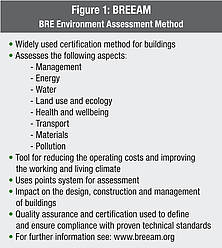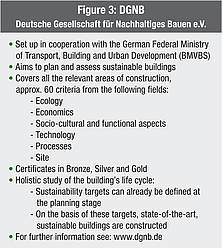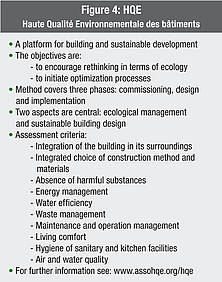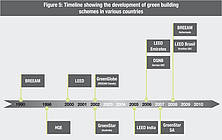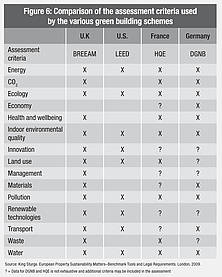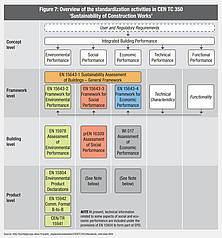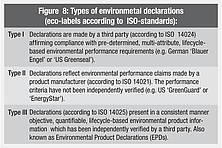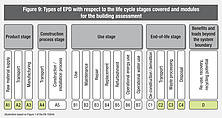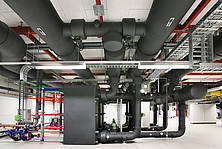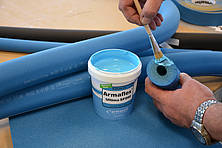By Dipl.-Ing. Georg Eleftheriadis, Armacell Manager Technical Marketing Europe
Münster, 14 June 2013 – Not just an ecological fad, but a forward-looking trend: green building certification is becoming increasingly important in the construction and real-estate sector. Buildings that have been certified under BREEAM, LEED or a comparable national scheme not only emit less CO2, they can also be operated more economically and sold more profitably. Alongside the internationally recognized LEED certificate awarded by the US Green Building Council, the UK’s BREEAM system or the German DGNB there are numerous other public and private initiatives on both a national and international level. For the manufacturers, specifiers and users of construction products the large number of schemes and in particular their lack of comparability means that the product declarations they are based on cannot be compared directly with each other and so cannot be used across schemes.
European standard EN 15804, published in spring 2012, provides a methodology for evaluating the sustainability of construction products, based on a life cycle assessment (LCA). Environmental Product Declarations (EPDs) that are drawn up in accordance with EN 15804 describe the sustainability performance of construction products. As a ‘sustainability passport’ for construction products, and in particular for insulation materials in the building industry, they will be a core element of green building certification in the future and are expected to lead to better comparability between the different schemes.
Sustainability – a sustainable trend in the construction industry?
Everyone is talking about sustainability.
This key term of our times has become an overused buzzword in some ways; it can be encountered in almost every area of life. In Germany, the adjective ‘nachhaltig’ (sustainable) was in the final selection for the ‘Word of the Year’ as early as 1998. Depending on where they come from, people tend to as-sume a slightly different historical background to the term and ‘occupy’ the concept of sustainability by searching for (and often finding) proof of this concept having been ‘invented’ in their own national history. A little Internet research reveals interesting results [1][2][3][4]. There are numerous explanations and definitions of this word and it would be easy to lose one’s bearings without the clear boundaries – at least for some areas of life – which help to flesh it out.
For this brief article on the subject of green building schemes for construction products, we assume a very broadly defined concept of sustainability that can be derived from the Brundtland Report [5]. According to this, sustainability is a ‘… development that satisfies the needs of the current generations without risking that future generations will not be able to satisfy their needs’.
For the construction sector this obviously means considering the conservation of resources, from the raw materials to the construction and demolition of buildings. As a building is not of a piece, but con-sists of many individual parts (known as construction components or elements), which in turn are made of various building materials, it is difficult to develop a simple system for assessing the sustainability of such a complex structure.
Established green building schemes in the construction sector
The green building schemes that exist for the construction sector are indeed rather complicated. The components examined and assessed for their sustainability are generally the building materials used, often referred to as construction products in the legal terminology (cf. also the definition in the CPR [8] and EN 15804 [6]). The aim of the individual green building schemes is to give the most specific information possible about the environmental and/or sustainability performance of buildings.
The green building schemes currently favoured by the market – such as LEED, BREEAM, DGNB etc. – are at heart all based on LCAs for (individual) construction products, the results of which are then transferred to (whole) construction works.
Alongside these holistic assessment systems there are, particularly in the Scandinavian countries, also a number of (pure) construction product assessment systems such as Sundahus, Basta or BVB (whereby BVB also allows a quasi-sustainability study for whole buildings).
From a historical point of view, the European green building schemes were the first to be launched. The UK’s Building Research Establishment Environmental Assessment Method (BREEAM) was intro-duced as early as 1990; the rather less well-known French assessment system Haute qualité environnementale (HQE - high environmental quality) was set up in 1996; whereas the US American Leadership in Energy and Environmental Design system (LEED) was introduced in 2000.
In Germany, the Deutsche Gesellschaft für Nachhaltiges Bauen (DGNB - the German society for sustainable building) did not establish a similar assessment scheme for buildings until 2008, so rela-tively late.
Figures 1 to 4 give brief descriptions of the systems and show their key aspects. Many other assess-ment schemes, which have now become established worldwide, are based mainly on the ‘Anglo-Saxon’ models LEED and BREEAM, e.g. BREEAM (Netherlands), LEED (Emirates) or Green Star (South Africa). Figure 5 shows a timeline for the development of the different green building schemes in various countries.
Lack of comparability between the green building schemes
There is a wide range of differences between the green building schemes and it is difficult to describe them simply. Staff at the universities of Regensburg (Germany) and Melbourne (Australia) undertook an extensive comparison of the key green building schemes [7]. In doing so they identified 18 sustainability criteria that play a role in most assessments. Figure 6 shows the criteria and their relevance for the green building schemes.
The findings of the scientific comparison are not particularly surprising: although some green building schemes are based on each other, there are great differences between the systems, even if similar or the same ratings are given. For example, with regard to sustainability aspects and environmental impact, a BREEAM ‘Excellent’ rating is not comparable to a LEED ‘Platinum’ rating for one and the same building.
So although the green building schemes for construction products all use LCA methods (mostly based on ISO standards such as ISO14040 [9], ISO 14044 [10] and ISO 14025 [11]), the individual approaches are extremely different. This also means that in the majority of cases manufacturers or users of these assessments are not able to compare the underlying product declarations or use them in other countries.
The authors therefore urgently call for the harmonization of the various green building schemes in order to achieve comparability. This would lead to greater acceptance among users and, as a conse-quence, to more rated buildings, both in the new and existing building sectors.
This recommendation is certainly to be supported. Greater transparency would also lead to stronger competition among the green building schemes and an improvement in the underlying methods and standards. The harmonization of the green building schemes can only succeed if the performance indicators on which the ratings are based and which are defined in the standards, are harmonized and use the same units/parameters.
These common, harmonized standards and performance indicators are a core requirement as far as the transparency and – in the end – the understanding and acceptance of the green building schemes are concerned.
European legislative initiative: Building Products Regulation integrates sustainability
This is the starting point for the European legislation: a key step towards sustainability-related legislation in European construction products law is the introduction of the Construction Products Regulation (CPR, EU 305/2011) [8]. The CPR was published in the European Official Journal on 4 April 2011 and following a transition period comes into force on 1 July 2013. It supersedes the Construction Products Directive (CPD) and unlike the latter does not have to be implemented in national law, but is valid throughout Europe as soon as it comes into force. In the CPR, Basic Work Requirements for construction products are stated.
Basic Work Requirement 3 (Hygiene, health and the environment) has been revised with the concept of sustainability in mind.
Sustainability itself is provided for in Basic Work Requirement 7 (Sustainable use of natural resources). According to this, the construction works must be designed, built and demolished in such a way that the use of natural resources is sustainable and in particular ensure the following:
(a) reuse or recyclability of the construction works, their materials and parts after demolition;
(b) durability of the construction works;
(c) use of environmentally compatible raw and secondary materials in the construction works.
Basic Work Requirements 3 and 7 of the CPR can only be achieved fully – if this is indeed possible – if the entire life cycle of a building is studied.
The European Commission issued a mandate to the European Committee for Standardization (CEN) to draw up the basic harmonized methodology for sustainability studies a few years ago.
This mandate (M/350) led to Technical Committee (TC) 350 (Sustainability of Construction Works) being set up in 2005.
CEN TC 350 is responsible for developing horizontal standards for assessing the sustainability aspects of new and existing buildings and for drawing up Environmental Product Declarations for construction products.
In the meantime, CEN TC 350 has drawn up a whole series of horizontal standards, which can be applied on a voluntary basis initially. Figure 7 gives an overview of the areas covered by TC 350.
The core methods for the assessment of the sustainability of construction products within the frame-work of the TC 350 system are described in EN 15804 (Sustainability of construction works - Environmental product declarations - Core rules for the product category of construction products).
Environmental Product Declarations (EPDs) describe the sustainability performance of construction products
In European standard 15804, the rules for Type III environmental declarations are described, which should be used as the basis for Environmental Product Declarations in Europe (see Figure 8).
Drawing up EPDs in accordance with EN 15804 is a universal method for making core environmental statements about construction products, which can then in turn be used to assess the building as a whole.
The requirements of this standard make sure that comparable LCA information on the environmental impact is provided, no matter where the construction product in question is manufactured or used. This information may concern energy consumption, resource consumption or the recycling rate, for example. Information about environmental impacts such as eutrophication, the greenhouse effect or smog and toxic effects on human health or the environment can also be given.
It is ensured that the core statements about the product can be used by the different assessment schemes (at least throughout Europe).
Furthermore, compliance with EN 15942 (Sustainability of construction works - Environmental product declarations - Communication format business-to-business) will also lead to the standardization of communication formats for EPDs, at least in the business-to-business area.
Although EN 15804 (together with EN 15942) refers to an information framework that should be used, this does not necessarily mean that the resulting EPDs will have a standardized layout or design. The EPDs of various construction products and assessment schemes will very probably look very different.
However, compliance with the standards guarantees that the same environmental indicators and the same environmental modules are used to describe the impact-related environmental performance of the product and building (see Figure 9).
EPDs in accordance with EN 15804 describe the sustainability performance of a product related to 17 life cycle modules: the product stage consists of three modules: Raw materials supply (A1), Transport (A2) and Manufacturing (A3). EPDs that only take these three modules into account are referred to as cradle-to-gate declarations.
The environmental information provided by an EPD which covers all stages of the life cycle (from the cradle to the grave) must be divided into the information module groups A1 – A3, A4 – A5, B1 – B5, B6 – B7, C1 – C4 and module D.
However, only the declaration of the product stage modules, A1 – A3, is mandatory for compliance with EN 15804. The declaration of the modules for the other stages of the life cycle is voluntary.
EN 15804 also lists 24 environmental indicators (parameters to describe the environmental impact), which could play a potential role and therefore become part of an EPD. Seven of these environmental indicators refer to environmental aspects (e.g. global warming, ozone depletion, eutrophication etc.); ten environmental indicators concern the use of resources (e.g. renewable primary energy, secondary materials, fresh water resources etc.); three indicators are defined for waste and disposal and there are a further four for output flows, which describe the material quantities that leave the defined system boundaries of the EPD for a specific product and are used for other products (e.g. through re-use or recycling).
The completion of EN 15804 by the work of CEN TC 350 means that it should be possible to draw up EPDs for construction products that can be used consistently throughout Europe. Many European EPD programme operators have already begun to adapt their EPD system to the provisions of EN 15804.
EPDs for technical insulation materials
The fundamental work performed by TC 350 has driven forward intensive activities for insulation materials. Within CEN TC 88 (Thermal insulating materials and products) a working group has been founded to define the necessary Product Category Rules (PCRs). These PCRs will form the basis for the application of EN 15804 for thermal insulation materials.
Insulation materials generally score well in terms of sustainability, because much more energy is saved during their use stage than is consumed in the production and disposal stage. This fact has been taken into account and mentioned in the drafts of the PCR for insulation materials.
However, because the PCRs also depend to a large extent on the installation conditions and situa-tions, at least when the use stage of the product is studied, there is still a need for further clarification in TC 88.
Whether and to what extent it makes sense to give a detailed description of the intended use of the insulation materials (perhaps in the form of insulation product-specific standards), will have to be decided in the coming weeks.
The next important step towards considering the sustainability aspects of thermal insulation products for buildings, building equipment and industrial installations in Europe will be their integration into the CE system. Although some good groundwork has already been done, there still seems to be a long way to go.
Conclusions
In conclusion, it can be stated that EN 15804 and the stepwise adoption of its requirements throughout Europe form a solid basis for creating (or reviving) broad acceptance for the concept of sustainability across all stakeholder levels.
In future, as a core element of green building schemes, EPDs will play a central role as ‘sustainability passports’ for construction products, and especially for thermal insulation products in the building sector. The European standard paves the way for the cross-border recognition and use of Environmental Product Declarations in Europe.They will be an integral part of every product description and provide everyone involved with reliable information and greater certainty when using the products.
References:
[1] Nachhaltigkeit – Wikipedia (D): https://de.wikipedia.org/wiki/Nachhaltigkeit
[2] Lexikon der Nachhaltigkeit: www.nachhaltigkeit.info/artikel/definitionen_1382.htm
[3] Alliance for Sustainability: http://www.afs.nonprofitoffice.com
[4] Sostenibilità - Wikipedia (I): http://it.wikipedia.org/wiki/Sostenibilit%C3%A0
[5] Report of the World Commission on Environment and Development: Our Common Future, an overview by the World Commission on Environment and Development: WCED Oslo, March 1987
[6] EN 15804, 2012: Sustainability of construction works - Environmental product declarations - Core rules for the product category of construction products
[7] International Comparison of Sustainable Rating Tools, Authors: Richard Reed, Anita Bilos, Sara Wilkinson, and Karl-Werner Schulte, The Journal of Sustainable Real Estate, Vol. 1, No. 1 – 2009, pp. 1 - 22
[8] REGULATION (EU) No. 305/2011 OF THE EUROPEAN PARLIAMENT AND OF THE COUNCIL of 9 March 2011 laying down harmonised conditions for the marketing of construction products and repealing Council Directive 89/106/EEC, Official Journal of the European Union (4.4.2011)
[9] ISO 14040:2006, Environmental management -- Life cycle assessment -- Principles and framework
[10] ISO 14044:2006, Environmental management -- Life cycle assessment -- Requirements and guidelines
[11] ISO 14025:2006, Environmental labels and declarations -- Type III environmental declarations -- Principles and procedures

